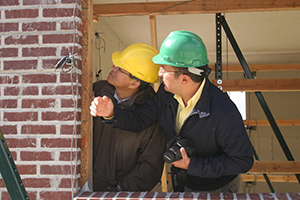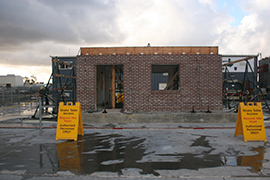Engineers Try to ‘Bring Down the House’ During Simulated Earthquake Tests
Andrea Siedsma | February 2, 2009
Engineers at the University of California at San Diego put a single-story house to the test on January 26 via a series of strong simulated earthquake shakes. The first jolt to the wood-stud structure with brick veneer measured a 6.6 magnitude, with the final one came in at 7.2.
Wood stud frames with masonry veneer are commonly used for residential construction and also for commercial buildings throughout the United States. The goal of the tests is to improve the seismic performance of these types of structures and to provide design recommendations for new masonry buildings, including concrete masonry shear walls, concrete masonry walls with clay masonry veneer, and wood-stud frames with clay masonry veneer. The researchers shook their structure on the world’s only outdoor shake table, which is housed at the Jacobs School of Engineering’s Englekirk Structural Engineering Center at UC San Diego. The team is also studying the behavior of different connectors between clay masonry veneer and backing systems.

Masonry inspection: Jacobs School structural engineering professor Benson Shing (left) and Hussein Okail, a Jacobs School structural engineering postdoc, inspect damage to a wood-stud structure with brick veneer after putting it through a series of rigorous simulated earthquakes.
“Based on results obtained to date, we see a clear relationship between the methods used to attach veneer connectors to the wood-stud frame, and subsequent seismic performance,” said Richard Klingner, a civil engineering professor at the University of Texas at Austin and the lead researcher on the project. “Connectors attached by electro-galvanized box nails almost always failed by nail pullout, while connectors attached by screws rarely failed by screw pullout. We are evaluating the extraction capacities of different commercially available nails and screws, with the objective of refining our current design provisions for the types of fasteners used to attach veneer connectors to wood-stud frames.”
Another goal of the project—which also includes engineers from UC San Diego, North Carolina Agricultural and Technical State University and Washington State University—is to evaluate the safety of wood-stud frames with masonry veneer during earthquakes. Benson Shing, a structural engineering professor at the UC San Diego Jacobs School of Engineering and one of the co-principal investigators on the project, said that during the tests the wood-frame structure with masonry veneer did not collapse under levels of intense shaking.

Engineering researchers will use data from recent simulated earthquake tests at the UC San Diego Englekirk Structural Engineering Center to revamp building codes for the masonry industry.
“One of our objectives was to see whether refinements to current design approaches are possible for wood-frame structures with masonry veneer,” Shing said. “We had promising results.”
Preliminary test results indicate that masonry veneer can help the seismic performance of wood-stud structures, according to Klingner. The researchers will now use measurements and computer predictions to develop design recommendations for the masonry industry.
“Our ultimate goal is to make buildings safe,” Klingner said. “If we can do that, we reduce loss
of life, human tragedy, and also monetary loss.”
The earthquake tests are being conducted at the Jacobs School of Engineering’s Englekirk Structural Engineering Center, which is about eight miles east of the university’s main campus. The Englekirk shake table is one of 15 earthquake testing facilities that make up the National Science Foundation’s Network for Earthquake Engineering Simulation (NEES). The UCSD-NEES shake table, the largest in the United States and the only outdoor shake table in the world, is ideally suited for testing tall, full-scale buildings.

|